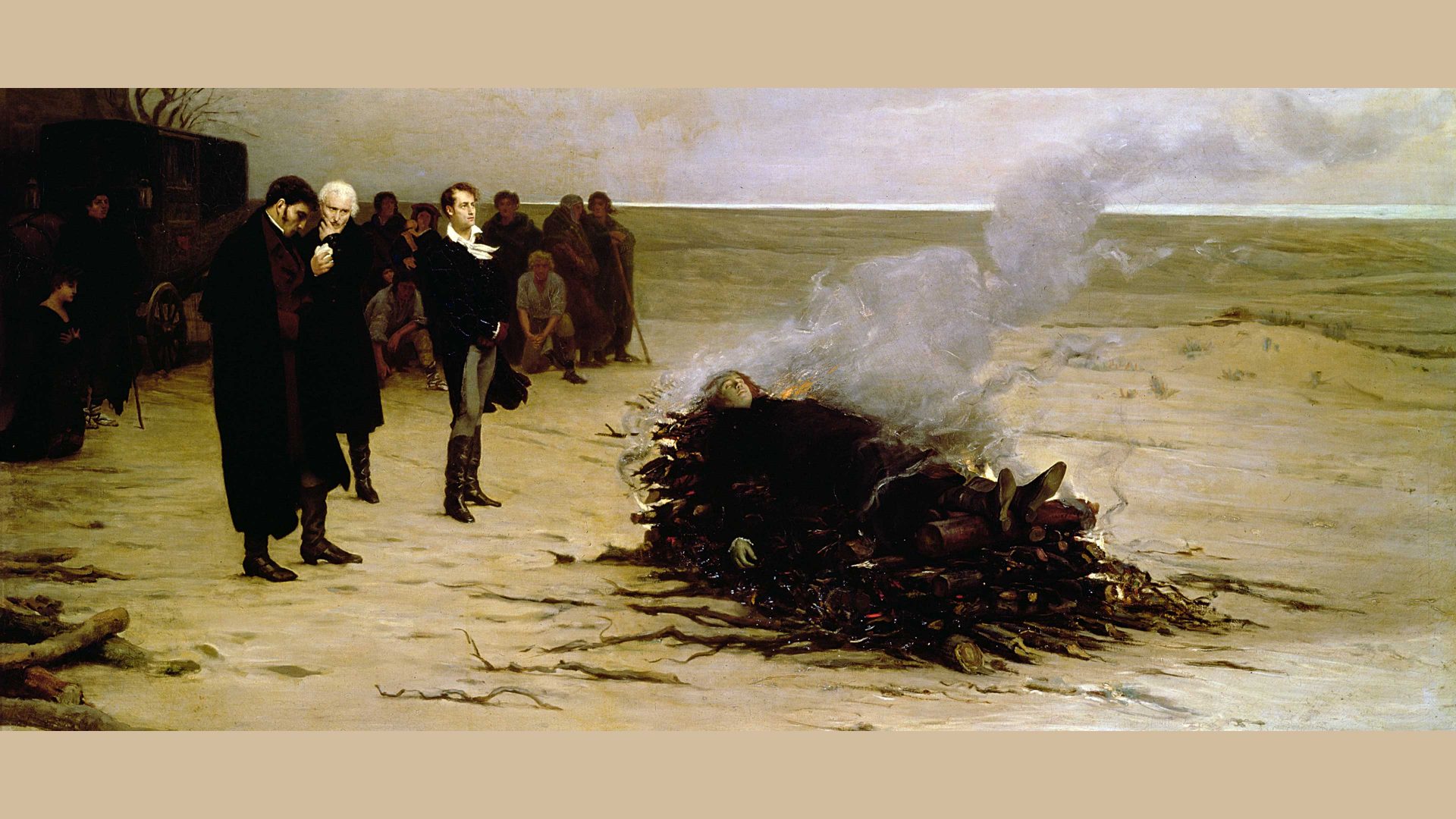It was the kind of storm the Romantics dreamed of. Sudden and violent, rolling black clouds racing across the clear blue sky over the Ligurian Sea, the wind barrelling over the water, first whipping up white caps then churning up a boiling dark mass of towering waves, sheets of rain illuminated by lightning followed by shuddering booms of thunder beneath the roar of the wind and the crashing of the raging sea.
Viewed from the shore it would have been spectacular, inspiring even. But in the late afternoon of July 8, 1822, 200 years ago this week, Percy Bysshe Shelley was fighting for control of the Don Juan, a small boat right in the teeth of such a storm, waves breaking over the vessel, aware the frantic bailing being attempted by his friend Edward Williams and an 18-year-old boat boy called Charles Vivian was not enough to stop them being swamped. The Don Juan was in full sail, their edges snapping and whipping viciously, the boom swinging back and forth: with just three on board there was no hope of reefing them in these conditions. With a terrible splintering, first one mast broke, then the other, covering the stricken boat and its occupants in a tangle of rope and canvas and causing a perilous list.
Soaked to the skin and with salt water stinging his eyes, Shelley realised they were going down. Instinctively he grabbed the volume of Keats’ poetry he had with him and shoved it deep into his pocket. Maybe it would prove some kind of talisman.
It was still there when his body washed up on the shore nearly three weeks later.
If ever there was a poet’s death it was Shelley’s. He was still young, a month shy of his 30th birthday, and only just beginning to fulfil his literary potential. His demise was as dramatic as it was tragic and has been mythologised ever since: rumours that he’d been murdered by pirates, or the sinking was actually an elaborate suicide as if an accidental drowning was too mundane for such a vibrant spirit.
Shelley was a reasonably experienced sailor, handling boats since childhood excursions on the rural Thames. His widow, Mary Wollstonecraft Shelley said that “much of his life had been spent on the water”. He’d sailed down the Arno, alone and with Williams, as well as down the Rhine and on Lake Geneva with Lord Byron, who had been repeatedly impressed by Shelley’s cool head, bravery and good sense on the water, not least when they were similarly imperilled by a storm during the tempestuous “year without a summer” of 1816.
Where he lacked experience, however, was on the sea. The Don Juan was new to him, a bigger vessel than he was used to. Twenty-four feet long, with two masts and a bowsprit capable of flying three jibs, the boat had only come into the poet’s possession seven weeks earlier.
The Shelleys had taken up residence at the Casa Magni, a boat house on the shore they shared with Williams and his wife, Jane, in San Terenzo in the Gulf of La Spezia on the Ligurian coast in April 1822. It was a time of extreme emotions for Shelley after a succession of infant deaths in his own and friends’ families and Mary suffering a miscarriage earlier in the summer that nearly killed her. Despite this he was working on his long poem The Triumph of Life as well as helping to launch the new radical journal The Liberal with Lord Byron.
He’d called Don Juan “the perfect plaything for the summer” and was exhilarated by early races against local Italian vessels that he passed “as a comet might pass the dullest planets of the Heavens”. Don Juan’s pace through the water might have convinced Shelley she was a sleeker boat than she was: she carried a large amount of sail and needed plenty of ballast. In June Shelley had even added two extra topmast sails and extended the prow and bowsprit, apparently determined to wring as much speed from the boat as he possibly could.
The alterations were made at the compromise of safety. Used to river and lake sailing, it’s possible Shelley had underestimated just how stormy the placid, azure summer waters off Liguria could become. Fast Don Juan may have been, but with her weight of sail already considerable for the size of her hull, even allowing for the amount of iron ballast she carried, and especially as a boat without a deck she was far from the most seaworthy vessel even before Shelley’s additions.
He’d set off south for Livorno, almost 50 miles along the coast, a week before the storm in good spirits. He was meeting the writer and publisher Leigh Hunt and his family, who had arrived in Italy to help with the planning of The Liberal, and escorting them to their lodgings in Pisa. After a week brimming with ideas and excitement for their new venture Shelley was keen to get home and immerse himself in work.
He woke on July 8 to perfect sailing conditions: a good southerly breeze, clear sky and smooth sea. Some accounts say he was warned of bad weather approaching from the south but weather forecasting was barely even in its infancy in 1822 so such predictions were often seen more a matter of speculation than fact. Anyway, Don Juan was a state-of-the-art vessel: with the amount of sail she carried Shelley was confident of outrunning any weather system that might loom up behind them. In these conditions, he told Williams and Vivian, they would be home in seven hours.
The first clouds massed ominously astern a couple of hours into the voyage. Another hour and the storm was upon them, raging and boiling the sea, waves crashing over the gunwales the top-heavy vessel filling and itching, its masts coming down and three doomed men pitched into water 50 fathoms deep 15 miles off Viareggio.
When Shelley’s and Williams’ bodies washed up on shore – Vivian’s was never found – Italian quarantine regulations meant they had to be buried immediately on the beach. Edward Trelawny, a friend of Byron and Shelley who had been due to sail Byron’s boat the Bolivar alongside Don Juan but was prevented from leaving Livorno by port bureaucracy, exhumed the poet and organised a funeral pyre, immortalised and romanticised by the artist Louis Édouard Fournier in a famous oil painting of 1889. Along with Shelley’s widow, Trelawny set about managing the poet’s legacy.
It wasn’t an easy task. Today Shelley is regarded as one of the greatest poets Britain ever produced but during his lifetime and the years that followed, his radical views ensured critical opinion was weighted firmly against him, even in death. A well-known atheist, a rarity at the time, Shelley had published a pamphlet arguing the non-existence of God during his student days at Oxford and alluded to the same view in some of his verse, most notably the radical Queen Mab. As a result, some British publications seemed to revel in his death.
“This gentleman, whose poetical talents were of a very high order but lamentably perverted in their direction, perished at sea on the 7th July” was how the Leeds Intelligencer reported news of his demise.
The Courier briefly noted the death of “the writer of some infidel poetry” and added: “now he knows whether there is a God or no”.
“Of the infidel Shelley we should speak in no compromising terms, were he still capable of future mischief,” wrote the Chronicle. “But he is dead and the world has no more to do with him.”
The Morning Post smirked at how “the atheist had sunk to the bottom of a fathomless abyss, either to rot into annihilation there, or but to deposit the lifeless body for whose gratification he had lived, that his disencumbered spirit might rise to the judgement of its God”. Three months later in an attack on both Byron and Shelley the same newspaper dubbed him “the Archdemon of Atheism”.
With Trelawny, Mary Shelley did her best among the hostility to manage her husband’s posthumous reputation but it took well over a century for his work to be recognised as among the best in the canon of literature in English. The rise of modernism in the early 20th century in particular condemned Shelley, with TS Eliot describing him as “humourless, pedantic, self-centred and sometimes almost a blackguard”. It took until the 1960s for Shelley’s verse to be re-evaluated and placed among the greats where it belongs.
We can only speculate as to what work he might have produced had he decided against sailing that day. Even so, a canon that includes the likes of Ode to the West Wind, Ozymandias and To a Skylark is a formidable enough legacy, well worth revisiting two centuries after his death.




